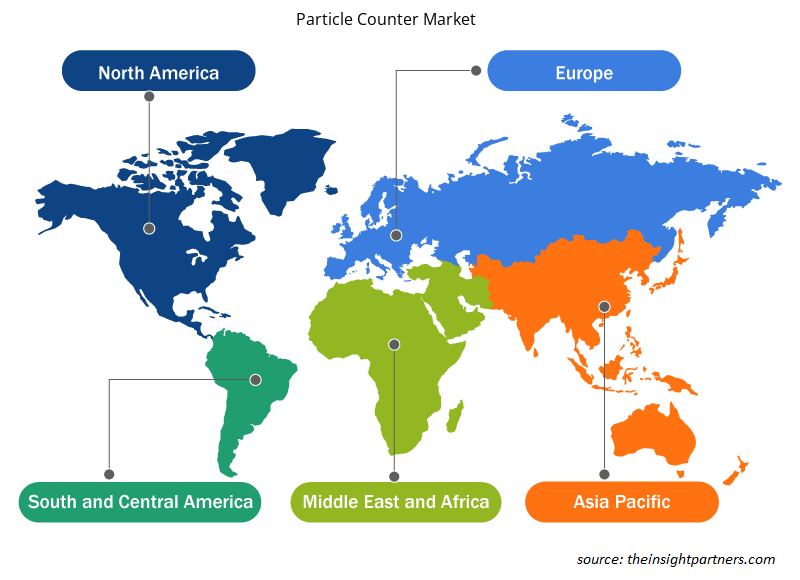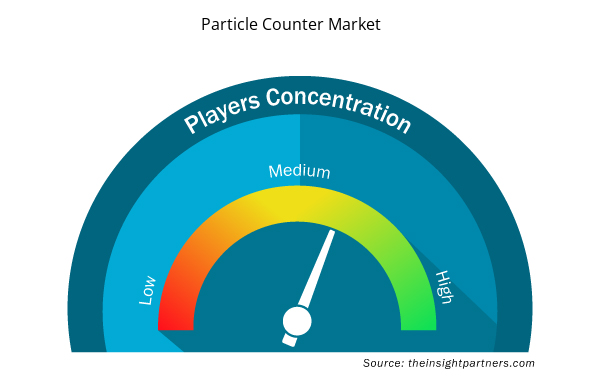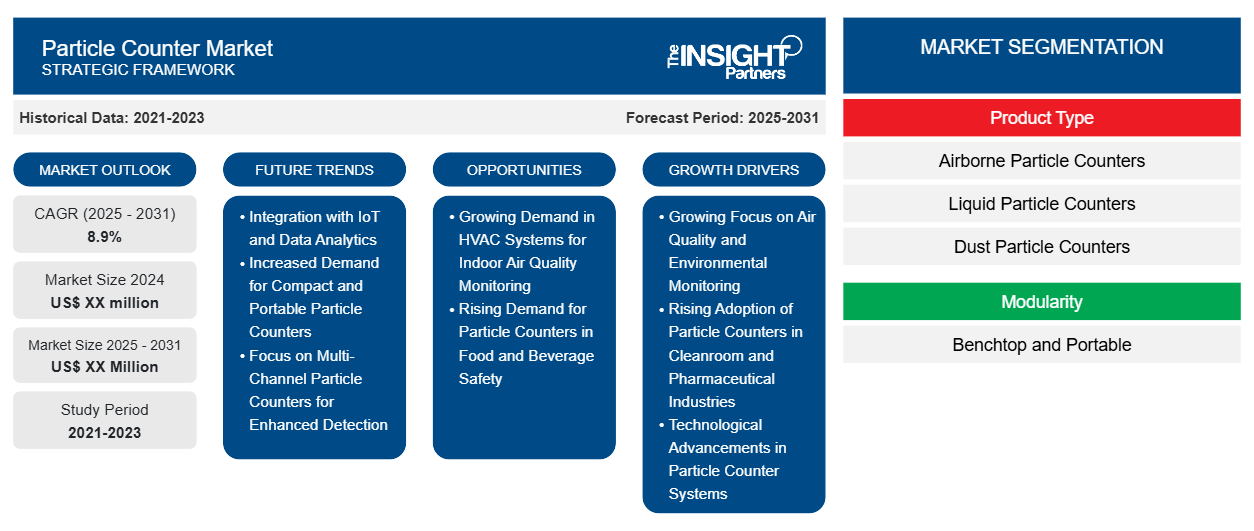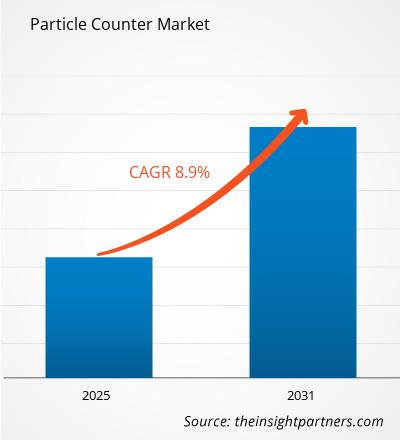Es wird erwartet, dass der Markt für Partikelzähler von 2023 bis 2031 eine durchschnittliche jährliche Wachstumsrate (CAGR) von 8,9 % verzeichnet, wobei die Marktgröße von XX Millionen US-Dollar im Jahr 2023 auf XX Millionen US-Dollar im Jahr 2031 wächst.CAGR of 8.9% from 2023 to 2031, with a market size expanding from US$ XX million in 2023 to US$ XX Million by 2031.
Der Bericht ist segmentiert nach Produkttyp (Luftpartikelzähler, Flüssigkeitspartikelzähler, Staubpartikelzähler und andere), Modularität (Tisch- und tragbare Geräte), Industrie (Lebensmittel und Getränke, Gesundheitswesen und Pharmazie, Öl und Gas, Automobil, Luft- und Raumfahrt und andere). Die globale Analyse ist weiter auf regionaler Ebene und in den wichtigsten Ländern aufgeschlüsselt. Der Bericht bietet den Wert in USD für die oben genannte Analyse und die Segmente.
Zweck des Berichts
Der Bericht „Partikelzählermarkt“ von The Insight Partners zielt darauf ab, die gegenwärtige Landschaft und das zukünftige Wachstum sowie die wichtigsten treibenden Faktoren, Herausforderungen und Chancen zu beschreiben. Dies wird verschiedenen Geschäftspartnern Einblicke geben, wie zum Beispiel:
- Technologieanbieter/-hersteller: Um die sich entwickelnde Marktdynamik zu verstehen und die potenziellen Wachstumschancen zu kennen, damit sie fundierte strategische Entscheidungen treffen können.
- Investoren: Durchführung einer umfassenden Trendanalyse hinsichtlich der Marktwachstumsrate, der finanziellen Marktprognosen und der Chancen entlang der Wertschöpfungskette.
- Regulierungsbehörden: Zur Regulierung von Richtlinien und Überwachungsaktivitäten auf dem Markt mit dem Ziel, Missbrauch zu minimieren, das Vertrauen der Anleger zu bewahren und die Integrität und Stabilität des Marktes aufrechtzuerhalten.
Partikelzähler Marktsegmentierung
Produkttyp
- Luftgetragene Partikelzähler
- Flüssigkeitspartikelzähler
- Staubpartikelzähler
- Sonstiges
Modularität
- Tischgerät und tragbar
Branchenvertikale
- Essen und Trinken
- Gesundheitswesen und Pharma
- Öl und Gas
- Automobilindustrie
- Luft- und Raumfahrt
- Sonstiges
Geographie
- Nordamerika
- Europa
- Asien-Pazifik
- Süd- und Mittelamerika
- Naher Osten und Afrika
Geographie
- Nordamerika
- Europa
- Asien-Pazifik
- Süd- und Mittelamerika
- Naher Osten und Afrika
Passen Sie diesen Bericht Ihren Anforderungen an
Sie erhalten kostenlose Anpassungen an jedem Bericht, einschließlich Teilen dieses Berichts oder einer Analyse auf Länderebene, eines Excel-Datenpakets sowie tolle Angebote und Rabatte für Start-ups und Universitäten.
- Holen Sie sich die wichtigsten Markttrends aus diesem Bericht.Dieses KOSTENLOSE Beispiel umfasst eine Datenanalyse von Markttrends bis hin zu Schätzungen und Prognosen.
Wachstumstreiber auf dem Partikelzählermarkt
- Wachsender Fokus auf Luftqualität und Umweltüberwachung: Das zunehmende Bewusstsein für Luftverschmutzung und ihre Auswirkungen auf die Gesundheit treibt die Nachfrage nach Partikelzählern an. Regierungen und Umweltorganisationen legen Wert auf die Überwachung der Luftqualität, um schädliche Schadstoffe, einschließlich Feinstaub (PM2,5 und PM10), zu reduzieren. Partikelzähler sind für die genaue Erkennung und Messung von luftgetragenen Partikeln in verschiedenen Umgebungen unerlässlich und unterstützen somit strenge Luftqualitätsvorschriften und Initiativen zur öffentlichen Gesundheit.
- Zunehmende Nutzung von Partikelzählern in Reinräumen und der Pharmaindustrie: Die Pharma- und Gesundheitsindustrie, in der sterile Umgebungen von entscheidender Bedeutung sind, benötigt Partikelzähler, um sicherzustellen, dass die Reinraumbedingungen den gesetzlichen Standards entsprechen. Diese Branchen verlassen sich auf Partikelzähler, um die Luftqualität zu überwachen, Verunreinigungen zu erkennen und die Sicherheit und Integrität der Produkte zu gewährleisten. Die strengen gesetzlichen Rahmenbedingungen für die Herstellungsbedingungen treiben die Nachfrage nach Partikelzählern in diesen Sektoren an.
- Technologische Fortschritte bei Partikelzählsystemen: Technologische Fortschritte bei Partikelzählsystemen, wie Echtzeitüberwachung, verbesserte Empfindlichkeit und drahtlose Datenübertragung, treiben den Markt voran. Diese Innovationen verbessern die Genauigkeit, Effizienz und Benutzerfreundlichkeit der Partikelzählung und ermöglichen es Branchen wie der Fertigung, der Pharmaindustrie und der Umweltüberwachung, Partikelverunreinigungen schnell zu erkennen und darauf zu reagieren. Die Entwicklung kleinerer, tragbarerer Geräte verbessert auch die Benutzerfreundlichkeit und treibt das Marktwachstum voran.
Zukünftige Trends auf dem Partikelzählermarkt
- Integration mit IoT und Datenanalyse: Die Integration von Partikelzählern mit Internet of Things (IoT)-Plattformen und Datenanalysetools ist ein wachsender Trend. IoT-fähige Partikelzähler können Echtzeitüberwachung und Fernzugriff auf Daten bieten, sodass Benutzer die Luftqualität oder Partikelkonzentration von überall aus verfolgen können. Die Möglichkeit, Daten für vorausschauende Wartung und Leistungsoptimierung zu sammeln und zu analysieren, steigert den Wert von Partikelzählern in verschiedenen Anwendungen.
- Erhöhte Nachfrage nach kompakten und tragbaren Partikelzählern: Es gibt einen steigenden Trend zu kompakten und tragbaren Partikelzählern, die Komfort und Flexibilität in unterschiedlichen Umgebungen bieten. Diese Handgeräte sind besonders in Branchen wie dem Gesundheitswesen, der Lebensmittelsicherheit und HLK-Systemen von Vorteil, in denen Mobilität und Benutzerfreundlichkeit von entscheidender Bedeutung sind. Da Endbenutzer bequemere und benutzerfreundlichere Lösungen verlangen, konzentrieren sich die Hersteller auf die Entwicklung kleinerer, leichterer und effizienterer Partikelzähler.
- Fokus auf Mehrkanal-Partikelzähler für verbesserte Erkennung: Die Nachfrage nach Mehrkanal-Partikelzählern wächst, da sie durch die gleichzeitige Messung von Partikeln in mehreren Größenbereichen verbesserte Erkennungsmöglichkeiten bieten. Dieser Trend ist besonders wertvoll in Branchen, die eine detaillierte und präzise Partikelanalyse erfordern, wie z. B. in der Halbleiterherstellung, in der Pharmaindustrie und in Reinräumen. Mehrkanalzähler ermöglichen eine schnellere, umfassendere Überwachung und führen so zu einer höheren Genauigkeit bei der Kontaminationskontrolle.cleanrooms. Multi-channel counters enable faster, more comprehensive monitoring, leading to increased accuracy in contamination control
Marktchancen für Partikelzähler
- Wachsende Nachfrage nach HLK-Systemen zur Überwachung der Luftqualität in Innenräumen: Das wachsende Bewusstsein für die Luftqualität in Innenräumen (IAQ) und ihre Auswirkungen auf die menschliche Gesundheit eröffnet Möglichkeiten für Partikelzähler im HLK-Sektor (Heizung, Lüftung und Klimaanlage). Gebäudeeigentümer und Facility Manager setzen zunehmend Partikelzähler ein, um die Luftqualität in Gewerbe- und Wohngebäuden zu überwachen und aufrechtzuerhalten. Dieser Trend dürfte den Markt für Partikelzähler ankurbeln, insbesondere da die gesetzlichen Standards für die Luftqualität in Innenräumen strenger werden.HVAC Systems for Indoor Air Quality Monitoring: The growing awareness of indoor air quality (IAQ) and its impact on human health is creating an opportunity for particle counters in the HVAC (heating, ventilation, and air conditioning) sector. Building owners and facility managers are increasingly adopting particle counters to monitor and maintain air quality within commercial and residential buildings. This trend is expected to drive the market for particle counters, especially as regulatory standards for indoor air quality become more stringent.
- Steigende Nachfrage nach Partikelzählern in der Lebensmittel- und Getränkesicherheit: Die Lebensmittel- und Getränkeindustrie setzt zunehmend Partikelzähler zur Kontaminationskontrolle in Herstellungs- und Verpackungsprozessen ein. Da die Vorschriften zur Lebensmittelsicherheit strenger werden und der Bedarf an sicheren, hygienischen Produkten steigt, werden Partikelzähler zu unverzichtbaren Werkzeugen zur Erkennung von Luftschadstoffen. Die wachsende Nachfrage nach Qualitätssicherung in der Lebensmittelproduktion bietet eine wichtige Chance für die Ausweitung des Partikelzählermarktes im Lebensmittel- und Getränkesektor
Regionale Einblicke in den Partikelzählermarkt
Die regionalen Trends und Faktoren, die den Partikelzählermarkt während des Prognosezeitraums beeinflussen, wurden von den Analysten von Insight Partners ausführlich erläutert. In diesem Abschnitt werden auch die Marktsegmente und die Geografie des Partikelzählermarkts in Nordamerika, Europa, im asiatisch-pazifischen Raum, im Nahen Osten und Afrika sowie in Süd- und Mittelamerika erörtert.

- Holen Sie sich die regionalspezifischen Daten für den Partikelzählermarkt
Umfang des Marktberichts über Partikelzähler
| Berichtsattribut | Details |
|---|---|
| Marktgröße im Jahr 2023 | XX Millionen US-Dollar |
| Marktgröße bis 2031 | XX Millionen US-Dollar |
| Globale CAGR (2023 - 2031) | 8,9 % |
| Historische Daten | 2021-2022 |
| Prognosezeitraum | 2024–2031 |
| Abgedeckte Segmente | Nach Produkttyp
|
| Abgedeckte Regionen und Länder | Nordamerika
|
| Marktführer und wichtige Unternehmensprofile |
|
Dichte der Marktteilnehmer für Partikelzähler: Die Auswirkungen auf die Geschäftsdynamik verstehen
Der Markt für Partikelzähler wächst rasant, angetrieben durch die steigende Nachfrage der Endnutzer aufgrund von Faktoren wie sich entwickelnden Verbraucherpräferenzen, technologischen Fortschritten und einem größeren Bewusstsein für die Vorteile des Produkts. Mit steigender Nachfrage erweitern Unternehmen ihr Angebot, entwickeln Innovationen, um die Bedürfnisse der Verbraucher zu erfüllen, und nutzen neue Trends, was das Marktwachstum weiter ankurbelt.
Die Marktteilnehmerdichte bezieht sich auf die Verteilung der Firmen oder Unternehmen, die in einem bestimmten Markt oder einer bestimmten Branche tätig sind. Sie gibt an, wie viele Wettbewerber (Marktteilnehmer) in einem bestimmten Marktraum im Verhältnis zu seiner Größe oder seinem gesamten Marktwert präsent sind.
Die wichtigsten auf dem Partikelzählermarkt tätigen Unternehmen sind:
- Airy-Technologie
- Chemtrac Inc.
- Climet Instruments Unternehmen
- Extech Instruments (FLIR Systems)
- Fluke Corporation
Haftungsausschluss : Die oben aufgeführten Unternehmen sind nicht in einer bestimmten Reihenfolge aufgeführt.

- Überblick über die wichtigsten Akteure auf dem Partikelzählermarkt
Wichtige Verkaufsargumente
- Umfassende Abdeckung: Der Bericht deckt die Analyse von Produkten, Dienstleistungen, Typen und Endbenutzern des Partikelzähler-Marktes umfassend ab und bietet einen ganzheitlichen Überblick.
- Expertenanalyse: Der Bericht basiert auf dem umfassenden Verständnis von Branchenexperten und Analysten.
- Aktuelle Informationen: Der Bericht stellt durch die Abdeckung aktueller Informationen und Datentrends Geschäftsrelevanz sicher.
- Anpassungsoptionen: Dieser Bericht kann angepasst werden, um spezifische Kundenanforderungen zu erfüllen und die Geschäftsstrategien optimal anzupassen.
Der Forschungsbericht zum Partikelzählermarkt kann daher dabei helfen, die Branchensituation und Wachstumsaussichten zu entschlüsseln und zu verstehen. Obwohl es einige berechtigte Bedenken geben kann, überwiegen die allgemeinen Vorteile dieses Berichts tendenziell die Nachteile.
- Historische Analyse (2 Jahre), Basisjahr, Prognose (7 Jahre) mit CAGR
- PEST- und SWOT-Analyse
- Marktgröße Wert/Volumen – Global, Regional, Land
- Branche und Wettbewerbsumfeld
- Excel-Datensatz



Report Coverage
Revenue forecast, Company Analysis, Industry landscape, Growth factors, and Trends

Segment Covered
This text is related
to segments covered.

Regional Scope
North America, Europe, Asia Pacific, Middle East & Africa, South & Central America

Country Scope
This text is related
to country scope.
Häufig gestellte Fragen
Some of the customization options available based on the request are an additional 3-5 company profiles and country-specific analysis of 3-5 countries of your choice. Customizations are to be requested/discussed before making final order confirmation# as our team would review the same and check the feasibility
Shift Towards Portable Devices
The report can be delivered in PDF/PPT format; we can also share excel dataset based on the request
Increasing Stringency of Regulations, Rising Research and Development Activities, Growth in Cleanroom Applications
The Particle Counter Market is estimated to witness a CAGR of 8.9% from 2023 to 2031
Trends and growth analysis reports related to Electronics and Semiconductor : READ MORE..
1.Airy Technology2.Chemtrac Inc.3.Climet Instruments Company4.Extech Instruments (FLIR Systems)5.Fluke Corporation6.Kanomax USA, Inc.7.Met One Instruments Inc.8.PAMAS - Partikelmess- und Analysesysteme GmbH9.Rion Co., Ltd.10.TSI Incorporated
The Insight Partners performs research in 4 major stages: Data Collection & Secondary Research, Primary Research, Data Analysis and Data Triangulation & Final Review.
- Data Collection and Secondary Research:
As a market research and consulting firm operating from a decade, we have published and advised several client across the globe. First step for any study will start with an assessment of currently available data and insights from existing reports. Further, historical and current market information is collected from Investor Presentations, Annual Reports, SEC Filings, etc., and other information related to company’s performance and market positioning are gathered from Paid Databases (Factiva, Hoovers, and Reuters) and various other publications available in public domain.
Several associations trade associates, technical forums, institutes, societies and organization are accessed to gain technical as well as market related insights through their publications such as research papers, blogs and press releases related to the studies are referred to get cues about the market. Further, white papers, journals, magazines, and other news articles published in last 3 years are scrutinized and analyzed to understand the current market trends.
- Primary Research:
The primarily interview analysis comprise of data obtained from industry participants interview and answers to survey questions gathered by in-house primary team.
For primary research, interviews are conducted with industry experts/CEOs/Marketing Managers/VPs/Subject Matter Experts from both demand and supply side to get a 360-degree view of the market. The primary team conducts several interviews based on the complexity of the markets to understand the various market trends and dynamics which makes research more credible and precise.
A typical research interview fulfils the following functions:
- Provides first-hand information on the market size, market trends, growth trends, competitive landscape, and outlook
- Validates and strengthens in-house secondary research findings
- Develops the analysis team’s expertise and market understanding
Primary research involves email interactions and telephone interviews for each market, category, segment, and sub-segment across geographies. The participants who typically take part in such a process include, but are not limited to:
- Industry participants: VPs, business development managers, market intelligence managers and national sales managers
- Outside experts: Valuation experts, research analysts and key opinion leaders specializing in the electronics and semiconductor industry.
Below is the breakup of our primary respondents by company, designation, and region:

Once we receive the confirmation from primary research sources or primary respondents, we finalize the base year market estimation and forecast the data as per the macroeconomic and microeconomic factors assessed during data collection.
- Data Analysis:
Once data is validated through both secondary as well as primary respondents, we finalize the market estimations by hypothesis formulation and factor analysis at regional and country level.
- Macro-Economic Factor Analysis:
We analyse macroeconomic indicators such the gross domestic product (GDP), increase in the demand for goods and services across industries, technological advancement, regional economic growth, governmental policies, the influence of COVID-19, PEST analysis, and other aspects. This analysis aids in setting benchmarks for various nations/regions and approximating market splits. Additionally, the general trend of the aforementioned components aid in determining the market's development possibilities.
- Country Level Data:
Various factors that are especially aligned to the country are taken into account to determine the market size for a certain area and country, including the presence of vendors, such as headquarters and offices, the country's GDP, demand patterns, and industry growth. To comprehend the market dynamics for the nation, a number of growth variables, inhibitors, application areas, and current market trends are researched. The aforementioned elements aid in determining the country's overall market's growth potential.
- Company Profile:
The “Table of Contents” is formulated by listing and analyzing more than 25 - 30 companies operating in the market ecosystem across geographies. However, we profile only 10 companies as a standard practice in our syndicate reports. These 10 companies comprise leading, emerging, and regional players. Nonetheless, our analysis is not restricted to the 10 listed companies, we also analyze other companies present in the market to develop a holistic view and understand the prevailing trends. The “Company Profiles” section in the report covers key facts, business description, products & services, financial information, SWOT analysis, and key developments. The financial information presented is extracted from the annual reports and official documents of the publicly listed companies. Upon collecting the information for the sections of respective companies, we verify them via various primary sources and then compile the data in respective company profiles. The company level information helps us in deriving the base number as well as in forecasting the market size.
- Developing Base Number:
Aggregation of sales statistics (2020-2022) and macro-economic factor, and other secondary and primary research insights are utilized to arrive at base number and related market shares for 2022. The data gaps are identified in this step and relevant market data is analyzed, collected from paid primary interviews or databases. On finalizing the base year market size, forecasts are developed on the basis of macro-economic, industry and market growth factors and company level analysis.
- Data Triangulation and Final Review:
The market findings and base year market size calculations are validated from supply as well as demand side. Demand side validations are based on macro-economic factor analysis and benchmarks for respective regions and countries. In case of supply side validations, revenues of major companies are estimated (in case not available) based on industry benchmark, approximate number of employees, product portfolio, and primary interviews revenues are gathered. Further revenue from target product/service segment is assessed to avoid overshooting of market statistics. In case of heavy deviations between supply and demand side values, all thes steps are repeated to achieve synchronization.
We follow an iterative model, wherein we share our research findings with Subject Matter Experts (SME’s) and Key Opinion Leaders (KOLs) until consensus view of the market is not formulated – this model negates any drastic deviation in the opinions of experts. Only validated and universally acceptable research findings are quoted in our reports.
We have important check points that we use to validate our research findings – which we call – data triangulation, where we validate the information, we generate from secondary sources with primary interviews and then we re-validate with our internal data bases and Subject matter experts. This comprehensive model enables us to deliver high quality, reliable data in shortest possible time.


 Holen Sie sich ein kostenloses Muster für diesen Bericht
Holen Sie sich ein kostenloses Muster für diesen Bericht